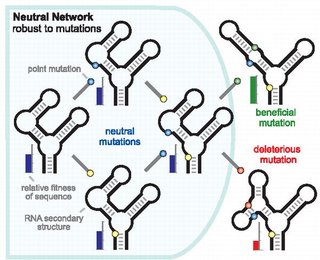eladó házak: Erdősmecske, 131 m2, 4 szoba, ID:515
Source:
Basic Back Pain Chiropractor Info
Going to the chiropractor for the first time can be unnerving. You may have heard all kinds of things, so having some basic back pain chiropractor info can be helpful. You will know what to expect and what kind of questions to ask your chiropractor. There are also some types of back pain that the chiropractor [...]
Source: feedproxy.google.com
Reasons To Improve Your Poor Posture
How often do we think of our posture as an overall body workout? Probably not at all, but it is essential to supporting structures of the body from being injured. Progressive deformities are also prevented by paying attention to your posture. Correct posture is less stress and tension on the joints and some muscles [...]
Source: feedproxy.google.com
Balancing Robustness and Evolvability
From PloS Biology:
Balancing Robustness and Evolvability
Richard E. Lenski et al.
One of the most important features of biology is the ability of organisms to persist in the face of changing conditions. Consider the remarkable fact that every organism alive today is the product of billions of generations in which its progenitors, without fail, managed to produce progeny that survived to reproduce. To achieve this consistency, organisms must have a balance between robustness and evolvability, that is, between resisting and allowing change in their own internal states [1 - 3]. Moreover, they must achieve this balance on multiple time scales, including physiological responses to changes over an individual life and evolutionary responses, in which a population of genomes continually updates its encoded information about past environments and how future generations should respond given that record.
Examples of robust biological systems are found at many scales, from biochemical to ecological. At each scale, robustness may reflect the properties of individual elements or, alternatively, the dynamic feedbacks between interacting elements. The expression of some metabolic function, for example, may be robust in the face of temperature change, because an enzyme maintains its shape and specificity across a range of temperatures or because an interconnected network of reactions sustains the supply of product, even when some enzyme fails. A genome may be robust because it encodes proofreading and repair systems that reduce replication errors or because it is organized such that many mutations have little effect on its phenotype. An ecosystem might be robust if it resists the extinction of some keystone species or, if extinction does occur, because surviving species can compensate over physiological, demographic, or evolutionary time scales.
One important question is whether there exists a single unifying mathematical framework that can encompass such diverse examples of biological robustness. Might new insights come from such a conceptual unification, or will future understanding require detailed analyses of specific cases? Across the different scales, recurring mechanisms for achieving robustness - including redundancy of component parts and negative feedbacks - might serve as organizing principles. Yet, similarities in mechanism could mask important differences in the evolutionary origins of those mechanisms. At the level of genes in genomes or of cells in multicellular organisms, it is reasonable to suggest that redundancy evolved by natural selection to maintain some functional capacity in the face of perturbation [4]. But whereas species redundancy could also be critical for robustness of ecosystem functions, differences in redundancy might be an emergent property rather than an ecosystem-level adaptation, because selection generally acts at lower levels (but see [5] for another view).
Continued at "Balancing Robustness and Evolvability" [A modified version of this post (with background info) will be posted to the "General Evolution News" category]
Technorati: balancing, robustness, evolvability, biology, organisms, conditions, generations, progeny, genome, repair, systems, framework, genes, evolutionary, origins, multicellular, demographic, physiological, ecosytem, redundancy, richard, e, lenski, adaptation, phenotype, natural selection, emergent, property, level, keystone, species, extinction
Source: feedproxy.google.com
Chiropractic Adjustments
addthis_url = 'http%3A%2F%2Fbackpaininfoguide.com%2F2009%2F04%2Fchiropractic-adjustments%2F'; addthis_title = 'Chiropractic+Adjustments'; addthis_pub = '';
Source: feedproxy.google.com
Lumbar Spinal Stenosis Is A Pain In The Rear
There’s a diagnosis called Lumbar Spinal Stenosis. It’s a fancy name for a spine that has a narrowing channel which squeezes the nerves. These nerves lead to your backside and your legs, so there can be considerable pain. There’s lot of reasons why the spinal canal can be too narrow. For [...]
Source: feedproxy.google.com
Cardiovascular and diabetes mortality determined by nutrition
A non-pdf version can be found here
Abstract:
Overfeeding and overeating in families are traditions that are often transferred from generation to generation. Irrespective of these family traditions, food availability might lead to overfeeding, in its turn leading to metabolic adaptations. Apart from selection, could these adaptations to the social environment have transgenerational effects? This study will attempt to answer the following question: Can overeating during a child's slow growth period (SGP), before their prepubertal peak in growth velocity influence descendants' risk of death from cardiovascular disease and diabetes? Data were collected by following three cohorts born in 1890, 1905 and 1920 in Overkalix parish in northern Sweden up until death or 1995. The parents' or grandparents' access to food during their SGP was determined by referring to historical data on harvests and food prices, records of local community meetings and general historical facts. If food was not readily available during the father's slow growth period, then cardiovascular disease mortality of the proband was low. Diabetes mortality increased if the paternal grandfather was exposed to a surfeit of food during his slow growth period. (Odds Ratio 4.1, 95% confidence interval 1.33-12.93, P=0.01). Selection bias seemed to be unlikely. A nutrition-linked mechanism through the male line seems to have influenced the risk for cardiovascular and diabetes mellitus mortality. [evolution]
See New theory of environmental inheritance ('05 Press Release)
technorati tags: overfeeding, overeating, generation, family, food, selection, metabolic, adaptations, child, death, descendants, cardiovascular, disease, diabetes, sweden, parents, grandparents, mortality, mechanism, evolution
Source: feedproxy.google.com


Post a Comment